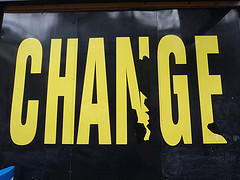
Photo credit: busy.pochi on Flickr
A coroner once told me that his job is to “find out what happened without laying blame.”
His aim is to “speak for the deceased” by explaining, as objectively as possible, what caused the death. Results are shared publicly when there’s a chance to prevent similar incidents to other people in the future.
I thought about this investigative approach recently when I saw a new WorkSafe Bulletin Incident investigations in health care: Focusing on change instead of blame.
Blame is like a hot potato sometimes – at work, in society, at home, on the roads. But what’s most important is taking note of “what went wrong” and doing all you can to prevent it from happening again. This applies to individuals and their various communities.
Looking back and shaking the finger of reproach is a waste of energy that could be used on positive solutions for the future. I’m not talking about cases of extreme negligence or intentional wrong-doing, but about other types of misjudgments, poor supervision, outmoded processes, and other factors that lead to bad outcomes.
“When an incident occurs in the workplace, a common reaction is to look for somewhere to place blame,” reads the bulletin.
“It’s more important and productive to look for reasons why the incident happened and what can be done to prevent it from recurring… focus on changes that will make the workplace safer, rather than blaming those involved in the incident.”
It calls for learning from your mistakes, as I see it, and the WorkSafe bulletin explains it well.
“Once you’ve identified what contributed to the incident, take corrective action. Consider targeting these actions at various levels of the organizations, such as the care team, department management, and senior management,” it reads, referring to the health care setting.
“If permanent corrective actions will take time to implement, use temporary measures to protect workers until you can make permanent changes.”
This approach applies beyond health care to other industries – and even to life in general, if you think about it. You do something. The outcome of your actions were not what you intended. You note “What went wrong” and figure out “how to do it right” next time. Simple, right?



I like how you finished this off; “figure out “how to do it right” next time.”
I think all improvements in safety should concentrate on making it safer to do the job, but the job must get done. Do the job safely is more important than being safe.
Thanks. Do the job safely – or be safe *while doing the job* – but for sure you’ve got to get the job done.
Once again great topic. Often during “Lessons Learned” or “Accident Review” meetings. The Coordinator of the meeting states at the very beginning, “This meeting is not to place blame but to learn for this incident and how to prevent it from happening again.” However, by the end of that meeting, a contractor, subcontractor or indvidual feels as though he/she has been verbally assaulted. If companies truly believe this statement there has got to be a better way to handle this “Review to make change.” Often after these sessions tough disciplinary actions are handed down. Now, I am not sayng that there are not times that this should not be done. I am just not certain if the focus on change is there during these sessions.